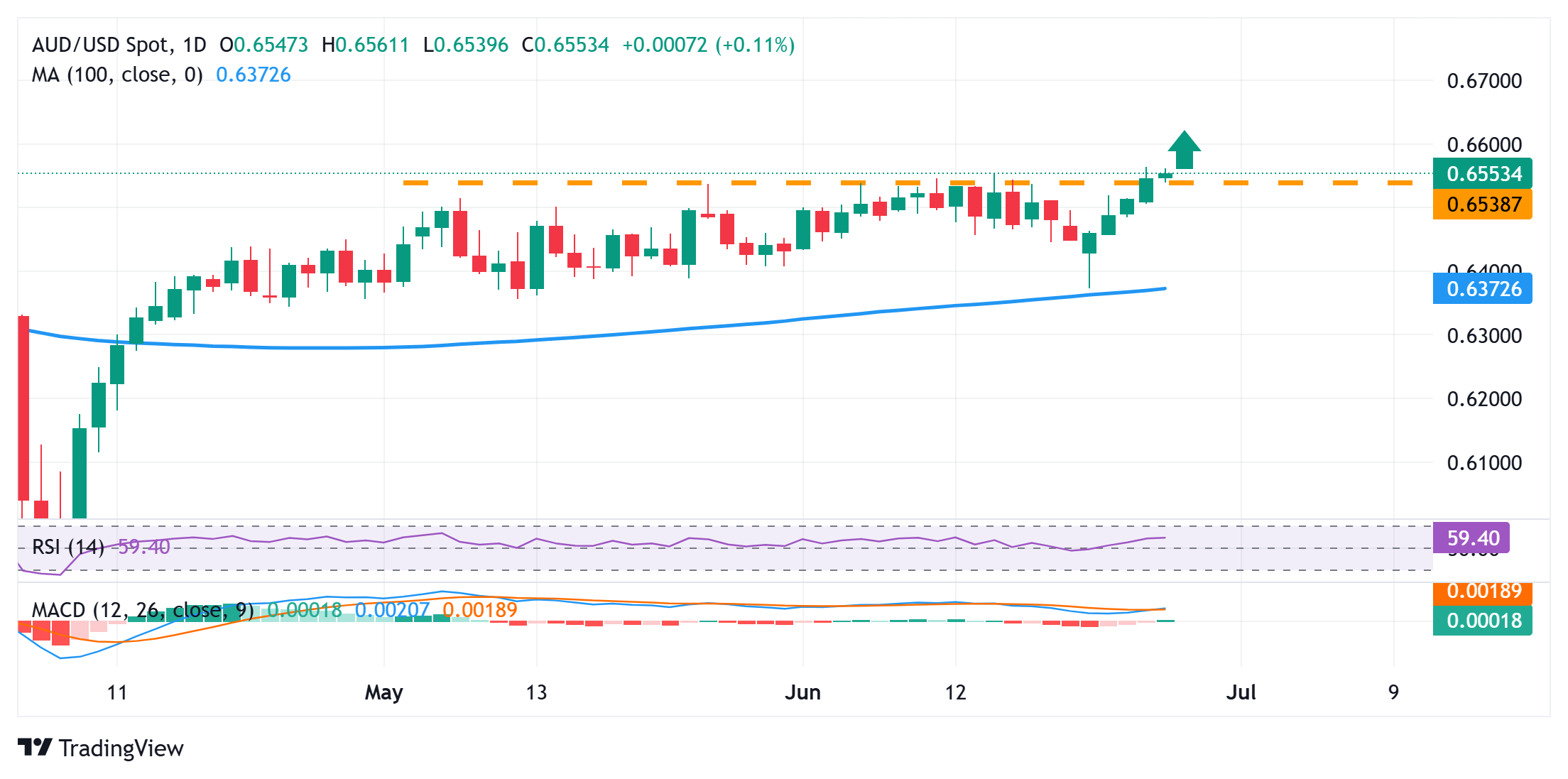
- AUD/USD sticks to a positive bias near the YTD peak amid a bearish USD.
- Fed independence fears and rate cut bets continue to weigh on the buck.
- Traders now look forward to the US PCE Price Index for a fresh impetus.
The AUD/USD pair holds steady around mid-0.6500s, just below a fresh year-to-date high touched the previous day as bulls turn cautious ahead of the US Personal Consumption Expenditure (PCE) Price Index. The crucial US inflation data is due for release later during the North American session and will play a key role in influencing market expectations about the Federal Reserve’s (Fed) rate cut path. This, in turn, will play a key role in influencing the near-term US Dollar (USD) price dynamics and provide a fresh directional impetus to the currency pair.
Heading into the key data risk, the USD languishes near its lowest level since March 2022 on the back of the growing acceptance that the Federal Reserve (Fed) will cut interest rates further this year. In fact, traders have been betting that the Fed would lower borrowing costs by at least 50 basis points (bps) before the end of this year and are also pricing in a roughly 20% chance of a rate reduction in July. The bets were reaffirmed by Thursday’s dismal US macro data, which, along with concerns about the Fed’s independence, fails to assist the USD to attract any buyers.
The Commerce Department’s third and final estimate released on Thursday showed that the US economy contracted more than previously estimated at the start of 2025 on the back of muted consumer spending and tariff-related disruptions. The US Gross Domestic Product (GDP) fell at an annualized rate of 0.5% during the January-March period, marking a steeper decline than the 0.2% reported in the second estimate. A separate report published by the US Labor Department showed that Continuing Claims rose by 37,000 to 1.974 million for the week ending June 14.
That was the highest level since November 2021 and suggested a sluggish hiring environment, fueling speculations that the US Unemployment Rate might tick up to at least 4.3% in June from 4.2% in May. This, in turn, could force the Fed to resume its rate-cutting cycle as early as next month. However, Fed Chair Jerome Powell maintained a wait-and-see approach to future interest rate decisions during his congressional testimony this week and said that he expects policymakers to stay on hold until they have a better handle on the impact of tariffs on consumer prices.
Powell’s position on interest rates remains at odds with US President Donald Trump, who has been calling for lower interest rates. Moreover, reports suggest that Trump was considering naming Powell’s successor by September or October, stoking concerns over the potential erosion of the Fed’s independence. Furthermore, the Israel-Iran ceasefire remains supportive of the upbeat market mood and is seen as another factor undermining the safe-haven USD, which, in turn, suggests that the path of least resistance for the risk-sensitive Aussie remains to the upside.
AUD/USD daily chart

Technical Outlook
The overnight move-up confirmed a breakout through the 0.6530-0.6540 supply zone and favors the AUD/USD bulls. This, along with positive oscillators on the daily chart, validates the near-term constructive outlook and backs the case for a move toward reclaiming the 0.6600 round-figure mark. The momentum could extend further towards the 0.6640 hurdle en route to the 0.6680 region, or November 2024 swing high.
On the flip side, any corrective pullback could attract fresh buyers near the 0.6500 psychological mark. This should help limit the downside for the AUD/USD pair near the 0.6465-0.6460 horizontal support. A convincing break below the latter, however, might expose the 0.6400 round figure before spot prices eventually drop to the 100-day SMA, around the 0.6375-0.6370 region. The latter coincides with the monthly low touched on Monday, which if broken might shift the near-term bias in favor of bearish traders.
Information on these pages contains forward-looking statements that involve risks and uncertainties. Markets and instruments profiled on this page are for informational purposes only and should not in any way come across as a recommendation to buy or sell in these assets. You should do your own thorough research before making any investment decisions. FXStreet does not in any way guarantee that this information is free from mistakes, errors, or material misstatements. It also does not guarantee that this information is of a timely nature. Investing in Open Markets involves a great deal of risk, including the loss of all or a portion of your investment, as well as emotional distress. All risks, losses and costs associated with investing, including total loss of principal, are your responsibility. The views and opinions expressed in this article are those of the authors and do not necessarily reflect the official policy or position of FXStreet nor its advertisers. The author will not be held responsible for information that is found at the end of links posted on this page.
If not otherwise explicitly mentioned in the body of the article, at the time of writing, the author has no position in any stock mentioned in this article and no business relationship with any company mentioned. The author has not received compensation for writing this article, other than from FXStreet.
FXStreet and the author do not provide personalized recommendations. The author makes no representations as to the accuracy, completeness, or suitability of this information. FXStreet and the author will not be liable for any errors, omissions or any losses, injuries or damages arising from this information and its display or use. Errors and omissions excepted.
The author and FXStreet are not registered investment advisors and nothing in this article is intended to be investment advice.








